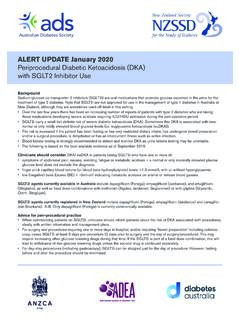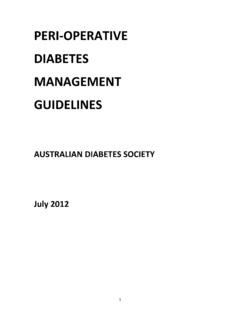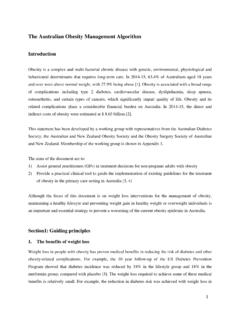Transcription of Peri-operative Diabetes Management Guidelines
1 Peri-operative . Diabetes . Management . Guidelines . AUSTRALIAN Diabetes SOCIETY. May 2011. 1. Table of Contents FOREWORD .. 4. SUMMARY .. 5. INTRODUCTION .. 6. RATIONALE FOR MAINTENANCE OF EUGLYCAEMIA .. 7. TARGETS FOR THERAPY .. 7. DEFINITIONS .. 8. PRE-OPERATIVE 9. GENERAL PRINCIPLES .. 10. patients WHO REQUIRE INSULIN THERAPY .. 11. Morning List .. 11. Major Surgery .. 12. Minor Surgery .. 12. Afternoon List .. 13. Major Surgery .. 13. Minor Surgery .. 14. Insulin-Glucose Infusion .. 15. Subcutaneous Insulin Infusion Pumps .. 15. patients WHO ARE NOT INSULIN REQUIRING.
2 15. patients on Diet Alone .. 15. patients on Oral AHG Medication (without insulin) .. 16. Major Surgery .. 16. Minor Surgery .. 16. 2. 17. Metformin and Surgery .. 17. Metformin and Intravenous 17. BOWEL PREPARATION .. 18. THE POST-OPERATIVE PERIOD .. 19. Sliding Scale Insulin .. 21. RADIOLOGICAL PROCEDURES .. 22. CONCLUSION .. 23. REFERENCES .. 24. Figure 1: Summary of Peri-operative Protocol for patients on the Morning list .. 28. Figure 2: Summary of Peri-operative Protocol for patients on the Afternoon List .. 29. Table 1: Bowel preparation for patients with Diabetes : while patients are on clear fluids.
3 30. Table 2: Summary of protocol for patients with Diabetes undergoing radiological studies .. 31. Examples of insulin adjustment .. 32. 3. FOREWORD. People with Diabetes are more likely to require admission to hospital (for conditions other than their Diabetes ) and are more likely to undergo surgery or other procedures that may potentially disrupt their glycaemic control. The metabolic impact of surgery, fasting and interruptions to usual therapy contribute to poor glycaemic control, which in turn is a significant factor contributing to the increased mortality, morbidity and length of hospital stay in patients with Diabetes undergoing surgery.
4 Minimising such disruptions has the potential to reduce the risk of such adverse outcomes. Pre- as well as Peri-operative Management of Diabetes is often provided in an ad-hoc fashion by staff with limited expertise in this area. Early discharge from hospital and the increasing use of day-only procedures have resulted in an increased burden on the patient and their carers for the Management of their Diabetes for which they may be ill-prepared and without adequate medical support. These Guidelines , developed by an ADS working group of Vincent Wong, Glynis Ross, Jennifer Wong and David Chipps (chair), are primarily intended to provide assistance for those practitioners whose primary focus is not Diabetes or do not have the support of local Diabetes expertise, in their Management of patients with Diabetes undergoing surgical procedures.
5 Evidence supporting much of the advice contained in these Guidelines is largely lacking, and indeed may never eventuate. They therefore represent a consensus of the opinions of the authors. They are not intended to replace protocols that may have been developed by other Diabetes experts that are appropriate for their specific hospital circumstances. As experience continues to be gained, Diabetes treatment options expand and surgical procedures advance, modifications to the advice contained therein may need to be made. By improving glycaemic control in the peri- operative period, it is hoped to reduce the potential for an adverse outcome for the patient with Diabetes who has undergone a surgical or investigative procedure.
6 4. SUMMARY. Prevention of hyperglycaemia reduces the risk of adverse outcomes post-operatively for people with Diabetes . Elective surgery should be postponed if possible if glycaemic control is poor. All patients treated with insulin should be managed in the same way, irrespective of the type of Diabetes . For the purposes of these Guidelines , all day-only surgery is regarded as minor, whereas surgery requiring over-night admission post-operatively is defined as major. Associated complications of Diabetes may affect the outcome of, as well as be affected by the surgery.
7 It is essential to ensure that patients with Diabetes undergoing day-only surgery are capable of and have written Guidelines about managing their Diabetes post-operatively, and that they have access to professional advice if glycaemic control deteriorates. Each surgical facility should have protocols to ensure that Diabetes control is not compromised by the surgical procedure, including the ability to commence an insulin-glucose infusion if necessary. The target blood glucose range post-operatively should generally be 5-10 mmol/L, although this can /should be modified in specific settings, ICU.
8 Surgery for patients with Diabetes should ideally be performed in the morning, as this is least disruptive to their usual Diabetes Management routine, and is least disruptive to their glycaemic control. It is important to ensure that the insulin-treated patient does not become insulin deficient and therefore hyperglycaemic at a time of metabolic stress, yet at the same time, ensure that the risk of hypoglycaemia is minimised at a time when the oral consumption of carbohydrate is restricted. An insulin-glucose infusion is the best way of maintaining euglycaemia post-operatively, especially in those previously treated with insulin, poorly controlled prior to admission, receiving more than one type of oral anti-hyperglycaemic medication, or who are not capable of resuming their usual diet and treatment.
9 Traditional sliding scale insulin is usually ineffective and a basal-bolus insulin regimen is preferable once the patient has resumed eating when post-operative insulin requirements are unknown. Insulin-treated patients undergoing major surgery on a morning operating list should commence an insulin-glucose infusion either prior to or at the time of induction of anaesthesia (or by 1000hrs at the latest) and the infusion should be continued for 24 hours post-operatively or until the patient is eating adequately. 5. Insulin-treated patients undergoing major surgery on an afternoon operating list should receive a modified dose of insulin (see specific instructions) with an early breakfast, be admitted early to the pre-operative ward for blood glucose monitoring, and commence an insulin-glucose infusion prior to the induction of anaesthesia.
10 Insulin-treated patients undergoing minor surgery on a morning operating list may be able to delay their morning insulin injection and breakfast until after the procedure, provided that they are first on the list, the procedure is short, and they will have recovered and be capable of eating by 1000hrs. Otherwise, a modified dose of insulin can be given in the morning (see specific instructions), with quick-acting insulin given before the first meal post-operatively. Insulin-treated patients undergoing minor surgery on an afternoon list should receive a modified dose of insulin in the morning (see specific instructions), some quick acting insulin before the first post-operative meal.



